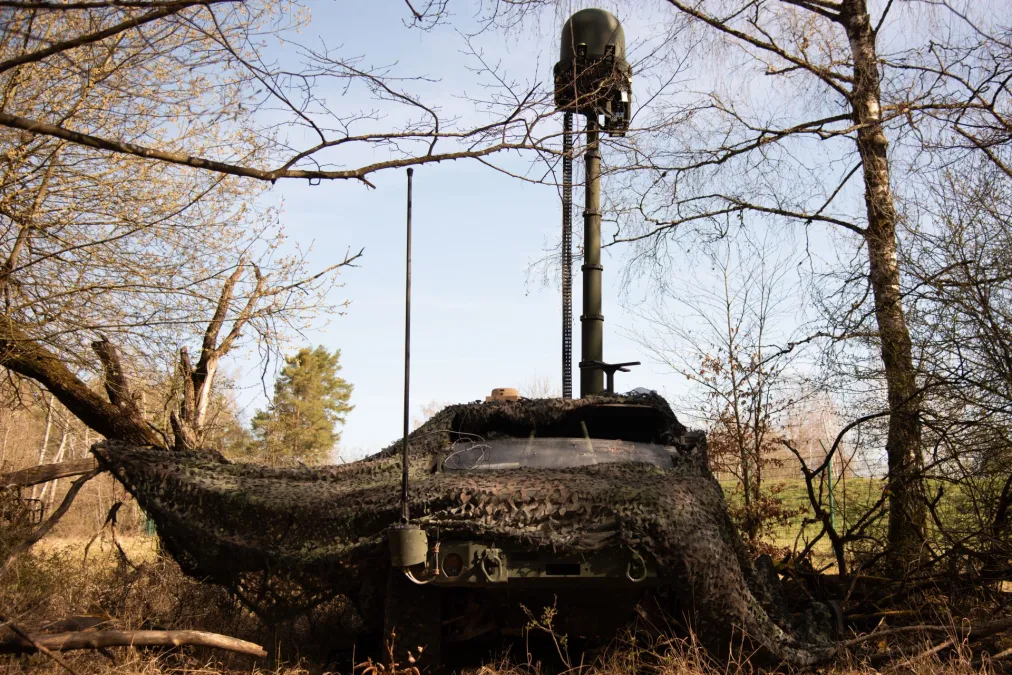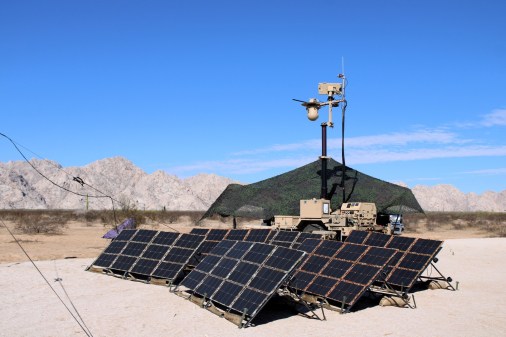Army’s new budget proposal invests in electromagnetic force protection capabilities

The Army’s fiscal 2026 budget request calls for several key investments in new programs and ongoing efforts aimed at protecting forces from enemy electronic warfare capabilities.
After divesting of much of its EW tool set following the Cold War, the Army has sought to rebuild its arsenal and tactics within the spectrum. That includes the gamut of electromagnetic spectrum operations such as electronic attack, or jamming, electronic support, or sensing the environment for enemy signals, and electronic protect, or guarding friendly systems and units from enemy jamming.
Observations from Ukraine have solidified the importance of robust and redundant capabilities, particularly within the spectrum.
In addition to having jammers for offensive actions, U.S. forces must possess a raft of other tools to be able to protect themselves from enemy jammers, hide within the spectrum and deceive the enemy.
As evidenced in Ukraine, units can be located and targeted with munitions solely based on their emissions within the electromagnetic spectrum.
“Commanders must be able to see themselves to control their emissions and defeat the enemy’s ability to sense, identify, locate, and target them. This is critically important when observations from current conflicts around the world show there are eight minutes from identification in the EMS to artillery impacting on the detected location of said emission,” the Army’s Multidomain Operations Range Guide states.
As such, the Army’s budget request would place more investments in these key areas of understanding its signatures and protecting forces with a combination of new-start programs, repurposed portfolios and existing efforts.
The Modular Electro-Magnetic Spectrum System (MEMSS) is a new start this budget cycle, stemming out of a prior science-and-technology effort called Modular Electromagnetic Spectrum Deception Suite (MEDS). Officials have previewed the effort in years past, noting some prototyping had gone toward developing it.
The Army is requesting $9.1 million in 2026 for the effort in its research-and-development budget. Specifically, it would provide force protection and freedom of maneuver through “radio frequency technical effects,” a term the Army uses to describe classified capabilities.
MEMSS will look to prioritize iterative development with commercial-off-the-shelf capabilities, a top priority for the Army and its electronic warfare portfolio overall.
The budget documents note that the system will be given to units as part of the Army’s transforming-in-contact (TiC) initiative, which aims to speed up how the service buys technologies and designs its forces and concepts by injecting emerging capabilities into units and letting them experiment with them during exercises and deployments.
The documents note that these units will receive prototyped capability and, as part of the program, fiscal ’26 funding will support testing to ensure it performs as expected against realistic threats to include both lab testing and evaluation from soldiers from TiC 2.0 units, which now involves armored formations as well as Multi-Domain Task Force and Army special operations units.
Another new start within the Army’s budget request is a program called Counter Surveillance Reconnaissance (CSR). It’s envisioned as a family of systems to provide force protection at echelon — specifically ground-based capabilities for division, corps and theater commanders — through enhanced situational awareness, operational planning tools for effects coordination and electronic support capabilities.
This program, along with many others, is included in the Army’s new Electronic Warfare Agile Systems Development program.
For this budget request, the Army sought to secure agile funding for a limited pot of systems: electronic warfare, unmanned aerial systems and counter-UAS. This agile funding allows the Army to consolidate capabilities into a single portfolio to better move money around and be more responsive to real-world events, as opposed to having to ask Congress for reprogramming requests. The budget documents note this pilot effort provides enhanced capabilities through fostering innovation and the accelerated development of promising technology.
The Army is requesting $34.4 million in R&D funding for CSR in fiscal 2026. The program aims to use technologies that will hide units’ locations within the electromagnetic spectrum. So-called low-probability-of-detection/low-probability-of-attribution non-kinetic effects will establish “unobserved” positions and preserve combat power, the documents note.
The CSR program will provide three distinct lines of effort for counter-space surveillance that will be controlled by an overarching mission planner and common execution software to plan and employ non-kinetic effects to protect friendly forces.
The prototype development for all three lines of effort are scheduled to begin in second quarter of 2026. The first unit issued for the first line of effort is scheduled for third quarter 2029, with the second and third slated for fourth quarter 2030.
The Army’s budget request is also asking for $1.5 million in R&D funding for a program to develop an integrated multi-mission electronic warfare force protection system.
That program, Integrated Electronic Warfare Systems, shifted in funding and terminology compared with last year’s budget release. It has now been moved to the agile funding pilot.
Additionally, in the previous budget proposal, the Army sought mainly to fund Counter-Radio Controlled Improvised Explosive Device (RCIED) Electronic Warfare (CREW), a term that is a relic of the Global War on Terror when insurgents used radio devices to trigger roadside bombs.
The CREW technology, however, is still relevant today as it can be used for counter-UAS and counter-communications.
Now, the program is aiming to prototype an integrated multi-mission electronic warfare force protection system that can respond to changing signals of interest employed by adversaries.
When a signal is discovered that isn’t in a unit’s library of known signals, a countermeasure must be devised, which historically could have taken months. That pace is unacceptable for the fast-paced warfare of the future. The Army and other services are looking at rapid reprogramming on the battlefield, in part, by leveraging artificial intelligence.
“Electromagnetic warfare (EW) capability gaps exist across several areas, including the need for development of more sophisticated countermeasures, and the integration of artificial intelligence (AI) and advanced analytics into EW operations. Specifically, the development of advanced countermeasures that can effectively disrupt or neutralize enemy EW capabilities is crucial, especially in the face of evolving technologies and tactics. Integrating AI and advanced analytics into EW operations will significantly enhance the ability to quickly identify and respond to threats,” the budget documents state. “VMEWS is intended to provide a suite of electromagnetic warfare capabilities to protect wheeled and tracked vehicles against a wide range of radio frequency-controlled threats.”
The Army expects a competitive commercial solutions offering that leads to an other transaction agreement for a tech demonstration of a vehicle mounted multi-mission electronic warfare force protection system to accelerate technology maturation and prototyping.
A new procurement effort for the Army in the budget request is the Spectrum Situational Awareness System (S2AS), which will provide sensing and visualization of what units look like in the spectrum and allow commanders to be able to sense and report in real-time their command post signatures, sources of electromagnetic interference — either from coalition partners or the enemy — and threat emissions.
The Army awarded 3dB Labs earlier this year an other transaction agreement to develop and demonstrate a prototype. S2AS had already undergone a prototyping effort prior to the award.
The fiscal 2026 budget request includes $17.6 million in procurement funding for S2AS as a new start in procurement and under the “Electronic Warfare” program, which is also new this year as part of the agile pilot. Those funds would enable procurement, delivery, training and initial sparing of S2AS, according to budget documents, which state the Army plans to buy 20 systems.
The budget also asks for $8.9 million in research-and-development funding for S2AS.
The Army will be using transforming-in-contact units to help inform how the program matures.






